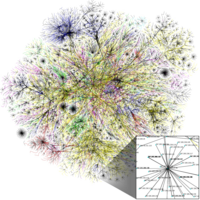
Photo from wikipedia
To investigate inter-scan and inter-scanner variation of iodine concentration (IC) and attenuation in virtual monoenergetic images at 65 keV (HU65keV) in patients with repeated abdominal examinations on dual-source (dsDECT), rapid… Click to show full abstract
To investigate inter-scan and inter-scanner variation of iodine concentration (IC) and attenuation in virtual monoenergetic images at 65 keV (HU65keV) in patients with repeated abdominal examinations on dual-source (dsDECT), rapid kV switching (rsDECT), and dual-layer detector DECT (dlDECT). We retrospectively included 131 patients who underwent two abdominal DECT examinations on the same scanner (dsDECT: n = 46, rsDECT: n = 45, dlDECT: n = 40). IC and HU65keV were measured by placing regions of interest in the liver, spleen, kidneys, aorta, portal vein, and inferior vena cava. Overall IC and HU65keV for each scanner, their inter-scan differences and proportional variation were calculated and compared between scanner types. The three scanner-specific cohorts showed similar weight, body diameter, age, sex, and contrast media injection parameters as well as inter-scan differences hereof (p range: 0.23–0.99). Absolute inter-scan differences of HU65keV and IC were comparable between scanners (p range: 0.08–1.0). Overall inter-scan variation was significantly higher in IC than HU65keV (p < 0.05). For the liver, rsDECT showed significantly lower inter-scan variation of IC compared to dsDECT/dlDECT (p = 0.005/0.01), while for the spleen, this difference was only significant compared to dsDECT (p = 0.015). Normalizing IC of the liver to the portal vein and of the spleen to the aorta did not significantly reduce inter-scan variation (p = 0.97 and 0.50). Iodine measurements across different DECT scanners show inter-scan variation which is higher compared to variation of attenuation values. Inter-scanner differences in longitudinal variation and overall iodine concentration depend on the scanner pairs and organs assessed and should be acknowledged in clinical and scientific DECT applications. • All scanner types showed comparable inter-scan variation of attenuation, while for iodine, the rapid kV switching DECT showed lower variability in the liver and spleen. • Iodine concentration showed higher inter-scan variation than attenuation measurements; normalization to vessels did not significantly improve inter-scan reproducibility of iodine concentration in parenchymal organs. • Differences between the three scanner types regarding overall iodine concentration and attenuation obtained from both timepoints were within the range of average intra-patient, inter-scan differences for most assessed organs and vessels.
Journal Title: European Radiology
Year Published: 2021
Link to full text (if available)
Share on Social Media: Sign Up to like & get
recommendations!